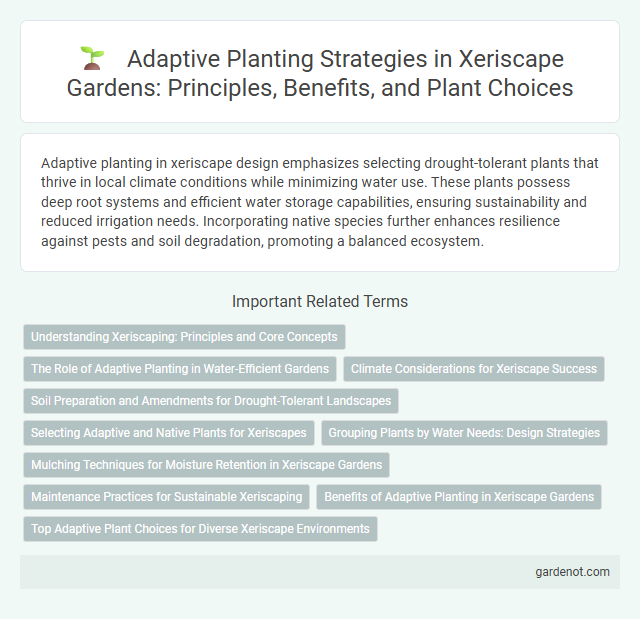Adaptive planting in xeriscape design emphasizes selecting drought-tolerant plants that thrive in local climate conditions while minimizing water use. These plants possess deep root systems and efficient water storage capabilities, ensuring sustainability and reduced irrigation needs. Incorporating native species further enhances resilience against pests and soil degradation, promoting a balanced ecosystem.
Understanding Xeriscaping: Principles and Core Concepts
Adaptive planting in xeriscaping emphasizes selecting drought-tolerant species that thrive in local climate conditions, reducing water usage significantly. Utilizing native plants with deep root systems enhances soil moisture retention and resilience during dry periods. Properly matching plant characteristics to microclimates within the landscape optimizes water efficiency and sustains healthy growth.
The Role of Adaptive Planting in Water-Efficient Gardens
Adaptive planting in xeriscape gardens significantly reduces water consumption by selecting drought-tolerant species suited to local climates. Incorporating native plants like succulents, ornamental grasses, and Mediterranean herbs enables efficient water use and soil moisture retention. Strategic placement of these adaptive plants enhances garden resilience, minimizes irrigation needs, and supports sustainable landscaping practices.
Climate Considerations for Xeriscape Success
Adaptive planting in xeriscape prioritizes selecting drought-tolerant species that thrive in arid and semi-arid climates, minimizing water usage while maintaining landscape health. Understanding regional climate patterns, such as temperature fluctuations, rainfall variability, and evapotranspiration rates, is critical for optimizing plant survival and growth. Integrating native plants with deep root systems enhances soil moisture retention and reduces irrigation needs, ensuring sustainable xeriscape success.
Soil Preparation and Amendments for Drought-Tolerant Landscapes
Effective soil preparation for xeriscape involves loosening compacted soil to improve aeration and water infiltration, essential for drought-tolerant plant health. Incorporating organic amendments like compost and aged manure enhances soil moisture retention and provides vital nutrients to support adaptive planting. Utilizing soil conditioners such as gypsum can improve soil structure and reduce runoff, optimizing water efficiency in drought-prone landscapes.
Selecting Adaptive and Native Plants for Xeriscapes
Selecting adaptive and native plants for xeriscapes enhances water efficiency and promotes ecosystem resilience by utilizing species naturally suited to local climate and soil conditions. Plants like desert marigold, yucca, and agave require minimal irrigation, reducing water consumption while supporting native wildlife habitats. Incorporating drought-tolerant varieties improves landscape sustainability and lowers maintenance costs in xeriscape gardens.
Grouping Plants by Water Needs: Design Strategies
Grouping plants by water needs in xeriscape design optimizes irrigation efficiency and conserves water resources. Implementing hydrozoning clusters drought-tolerant species separately from moisture-loving plants, allowing tailored watering schedules that reduce waste and promote healthy growth. Strategic placement of native and adaptive species enhances landscape sustainability while minimizing maintenance requirements and overall water consumption.
Mulching Techniques for Moisture Retention in Xeriscape Gardens
Mulching techniques in xeriscape gardens play a crucial role in moisture retention by reducing evaporation and regulating soil temperature, which conserves water in arid environments. Organic mulches such as wood chips, bark, and compost improve soil structure and promote microbial activity, enhancing moisture absorption and retention. Applying a 2-4 inch layer of mulch around drought-tolerant desert plants like succulents and native grasses optimizes water efficiency and supports adaptive planting strategies.
Maintenance Practices for Sustainable Xeriscaping
Adaptive planting in xeriscape emphasizes selecting drought-tolerant species that require minimal irrigation and fertilizer inputs. Maintenance practices prioritize soil health through mulching and efficient watering techniques such as drip irrigation to reduce water waste. Regular pruning and monitoring for pests ensure plant vigor while supporting long-term sustainability in arid landscapes.
Benefits of Adaptive Planting in Xeriscape Gardens
Adaptive planting in xeriscape gardens enhances water efficiency by selecting drought-tolerant species that thrive in arid conditions, significantly reducing irrigation needs. This approach promotes biodiversity by incorporating native plants that support local wildlife and improve soil health. Consequently, adaptive planting decreases maintenance costs and conserves natural resources, making xeriscape gardens sustainable and resilient in changing climates.
Top Adaptive Plant Choices for Diverse Xeriscape Environments
Top adaptive plant choices for diverse xeriscape environments include species such as Agave Americana, Sedum spurium, and Yucca filamentosa, known for their drought tolerance and low water requirements. Native plants like Penstemon and Echinacea also thrive under xeriscape conditions, providing ecological benefits and vibrant seasonal blooms. Selecting these resilient perennials and succulents maximizes water efficiency while enhancing soil stability and biodiversity in arid landscapes.
Adaptive planting Infographic

 gardenot.com
gardenot.com